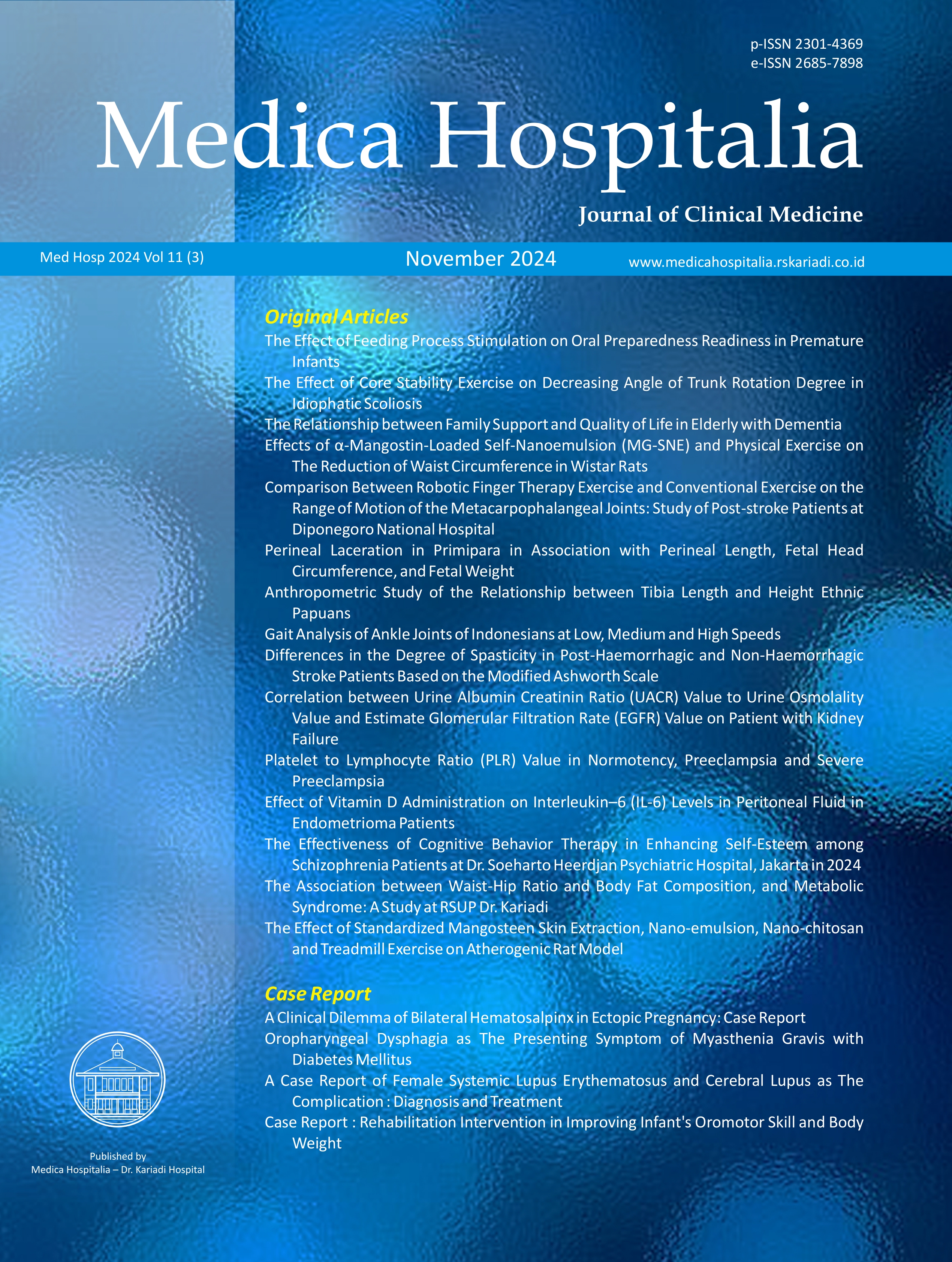The Association Vitamin D and Left Ventricular Hypertrophy in Metabolic Syndrome Patients
DOI:
https://doi.org/10.36408/mhjcm.v12i1.1196Keywords:
Cardiovascular Disease, Left Ventricular Hypertrophy, Metabolic Syndrome, Vitamin DAbstract
Background: Vitamin D deficiency is common, especially in people with metabolic syndrome. This condition increases the risk of cardiovascular problems, including left ventricular hypertrophy (LVH). While the connection between metabolic syndrome and LVH is well-documented, it is still unclear whether vitamin D deficiency alone contributes to the development of LVH in these patients.
Aim: To study the association between vitamin D levels and LVH in patients with metabolic syndrome.
Methods: A cross-sectional study was conducted with 38 patients diagnosed with metabolic syndrome in Kariadi Hospital, Semarang. Serum vitamin D levels were measured using the ELISA method, and LVH was diagnosed via echocardiography. Patients were categorized into normal and LVH groups. Vitamin D levels were classified as sufficient, insufficient, or deficient. The relationship between vitamin D levels, metabolic syndrome components, and LVH was analyzed.
Results: Our findings revealed no significant difference in vitamin D levels between patients with LVH and those without it (mean 19.98 ± 5.59 ng/mL for the LVH group vs. 20.91 ± 6.56 ng/mL for the normal group, p=0.65). However, patients with LVH had a significantly higher number of metabolic syndrome components compared to those without LVH (p=0.044).
Conclusion: While no direct association was found between vitamin D levels and LVH, the cumulative burden of metabolic syndrome components plays a significant role in the development of LVH. Future research should explore larger populations to investigate the therapeutic potential of vitamin D in cardiovascular outcomes.
Downloads
References
1. Cashman KD, Dowling KG, Škrabáková Z, Gonzalez-Gross M, Valtueña J, De Henauw S, et al. Global differences in vitamin D status and dietary intake: A review of the data. Endocr Connect. 2022;11(1):10–29. doi:10.1530/EC-21-0282.
2. Cashman KD, Sheehy T, O'Neill CM. Is vitamin D deficiency a public health concern for low middle-income countries? A systematic literature review. Eur J Nutr. 2018. doi:10.1007/s00394-018-1607-3.
3. Pusparini. Defisiensi vitamin D terhadap penyakit. Indones J Clin Pathol Med Lab. 2014;21(1):90–5. ISSN: 0854-4263.
4. Sun HL, Long SR, Fu SX, Chen GY, Wang YJ, Liang R, et al. Association between vitamin D levels and the risk of metabolic syndrome in a rural Chinese population. Biomed Environ Sci. 2021;34(4):330–3. doi:10.3967/bes2021.043.
5. Argano C, Mirarchi L, Amodeo S, Orlando V, Torres A, Corrao S. The role of vitamin D and its molecular bases in insulin resistance, diabetes, metabolic syndrome, and cardiovascular disease: State of the art. Int J Mol Sci. 2023;24(20):15485. doi:10.3390/ijms242015485.
6. Talaei A, Mohamadi M, Adgi Z. The effect of vitamin D on insulin resistance in patients with type 2 diabetes. Diabetol Metab Syndr. 2013;5(1):8. doi:10.1186/1758-5996-5-8.
7. Khademi Z, Hamedi-Shahraki S, Amirkhizi F. Vitamin D insufficiency is associated with inflammation and deregulation of adipokines in patients with metabolic syndrome. BMC Endocr Disord. 2022;22:223. doi:10.1186/s12902-022-01141-0.
8. Ratto E, Viazzi F, Verzola D, et al. Metabolic syndrome is associated with left ventricular dilatation in primary hypertension. J Hum Hypertens. 2016;30(2):158–63. doi:10.1038/jhh.2015.67.
9. Guerra F, Mancinelli L, Angelini L, Fortunati M, Rappelli A, et al. The association of left ventricular hypertrophy with metabolic syndrome is dependent on body mass index in hypertensive overweight or obese patients. PLOS ONE. 2011;6(1):e16630. doi:10.1371/journal.pone.0016630.
10. Min CY, Gao Y, Jiang YN, et al. The additive effect of metabolic syndrome on left ventricular impairment in patients with obstructive coronary artery disease assessed by 3.0 T cardiac magnetic resonance feature tracking. Cardiovasc Diabetol. 2024;23:133. doi:10.1186/s12933-024-02225-y.
11. Fallo F, Catena C, Camozzi V, Luisetto G, Cosma C, Plebani M, et al. Low serum 25-hydroxyvitamin D levels are associated with left ventricular hypertrophy in essential hypertension. Nutr Metab Cardiovasc Dis. 2012;22(10):871–6. doi:10.1016/j.numecd.2011.06.001.
12. Noor MN, Jamali AA, Rahu HN, Jamali GM, Memon AH, Phull GM. Correlation of vitamin D3 and serum calcium level with left ventricular hypertrophy patients. Prof Med J. 2020;27(6):1143–50. doi:10.29309/TPMJ/2020.27.06.3697.
13. Alberti KG, Zimmet P, Shaw J. Metabolic syndrome—a new worldwide definition. A consensus statement from the International Diabetes Federation. Diabet Med. 2006;23(5):469–80. doi:10.1111/j.1464-5491.2006.01858.x.
14. Lang RM, Bierig M, Devereux RB, Flachskampf FA, Foster E, Pellikka PA, et al. Recommendations for chamber quantification: A report from the American Society of Echocardiography’s Guidelines and Standards Committee and the Chamber Quantification Writing Group, developed in conjunction with the European Association of Echocardiography, a branch of the European Society of Cardiology. J Am Soc Echocardiogr. 2005;18(12):1440–63. doi:10.1016/j.echo.2005.10.005.
15. Thadhani R, Appelbaum E, Pritchett Y, et al. Vitamin D therapy and cardiac structure and function in patients with chronic kidney disease: The PRIMO randomized controlled trial. JAMA. 2012;307(7):674–84. doi:10.1001/jama.2012.120.
16. Herrero JA, López-Gómez JM, Maduell F, Martín-de Francisco ÁL, Martín-Malo A, Martínez-Castelao A, et al. Activation of vitamin D receptors in the optimization of secondary hyperparathyroidism on dialysis. Nefrologia. 2013;33(4):443–622. doi:10.3265/Nefrologia.pre2013.May.11901.
17. Raposo L, Martins S, Ferreira D, et al. Vitamin D, parathyroid hormone and metabolic syndrome – the PORMETS study. BMC Endocr Disord. 2017;17:71. doi:10.1186/s12902-017-0221-3.
18. Amirkhizi F, Khademi Z, Hamedi-Shahraki S, Rahimlou M. Vitamin D insufficiency and its association with adipokines and atherogenic indices in patients with metabolic syndrome: A case-control study. Front Endocrinol (Lausanne). 2023;14:1080138. doi:10.3389/fendo.2023.1080138.
19. Al Mheid I, Patel RS, Tangpricha V, Quyyumi AA. Vitamin D and cardiovascular disease: Is the evidence solid? Eur Heart J. 2013;34(48):3691–8. doi:10.1093/eurheartj/eht166.
20. Nigwekar SU, Bhan I, Thadhani R. Vitamin D, hypertension, left ventricular hypertrophy, and diastolic dysfunction. Curr Cardiovasc Risk Rep. 2011;5:314–22. doi:10.1007/s12170-011-0175-3.
21. Condoleo V, Pelaia C, Armentaro G, Severini G, Clausi E, Cassano V, et al. Role of vitamin D in cardiovascular diseases. Endocrines. 2021;2(4):417–26. doi:10.3390/endocrines2040037.
22. de Simone G, Devereux RB, Chinali M, Roman MJ, Lee ET, Resnick HE, et al. Metabolic syndrome and left ventricular hypertrophy in the prediction of cardiovascular events: The Strong Heart Study. Nutr Metab Cardiovasc Dis. 2009;19(2):98–104. doi:10.1016/j.numecd.2008.04.001.
23. Drożdż M, Moczulska A, Rudziński A, Drożdż D. Metabolic syndrome as risk factor for left ventricular hypertrophy in children with chronic kidney disease. Front Endocrinol (Lausanne). 2023;14:1215527. doi:10.3389/fendo.2023.1215527.
24. Papademetriou V, Devereux RB, Narayan P, Wachtell K, Bella JN, Gerdts E, et al. Similar effects of isolated systolic and combined hypertension on left ventricular geometry and function: the LIFE Study. Am J Hypertens. 2001;14(8 Pt 1):768–74. doi:10.1016/s0895-7061(01)01292-4.
25. Liu M, Li X, Sun R, Zeng Y, Chen S, Zhang P. Vitamin D nutritional status and the risk for cardiovascular disease: A review. Exp Ther Med. 2016;11(4):1189–93. doi:10.3892/etm.2016.3047.
26. Marttila J, Sipola P, Juutilainen A, et al. Central obesity is associated with increased left ventricular maximal wall thickness and intrathoracic adipose tissue measured with cardiac magnetic resonance. High Blood Press Cardiovasc Prev. 2024;31:389–99. doi:10.1007/s40292-024-00659-9.
27. Rodrigues S, Baldo M, Sá Cunha R, et al. Anthropometric measures of increased central and overall adiposity in association with echocardiographic left ventricular hypertrophy. Hypertens Res. 2010;33:83–87. doi:10.1038/hr.2009.188.
28. Zhang X, Li G, Zhang D, Sun Y. Influence of hypertension and global or abdominal obesity on left ventricular hypertrophy: A cross-sectional study. J Clin Hypertens. 2023;1–9. doi:10.1111/jch.14716.
29. Phanzu BK, Natuhoyila AN, Vita EK, Kabangu MJR, Longo-Mbenza B. Association between insulin resistance and left ventricular hypertrophy in asymptomatic, Black, sub-Saharan African, hypertensive patients: A case-control study. BMC Cardiovasc Disord. 2021;21(1):1. doi:10.1186/s12872-020-01829-y.
30. Yang M, Shangguan Q, Xie G, Sheng G, Yang J. Oxidative stress mediates the association between triglyceride-glucose index and risk of cardiovascular and all-cause mortality in metabolic syndrome: Evidence from a prospective cohort study. Front Endocrinol (Lausanne). 2024;15:1452896. doi:10.3389/fendo.2024.1452896.
31. Al-Aubaidy HA, Jelinek HF. Oxidative stress and triglycerides as predictors of subclinical atherosclerosis in prediabetes. Redox Rep. 2014;19(2):87–91. doi:10.1179/1351000213Y.0000000080.
32. Picard F, Bhatt DL, Ducrocq G, Ohman EM, Goto S, Eagle KA, et al. Generalizability of the REDUCE-IT trial and cardiovascular outcomes associated with hypertriglyceridemia among patients potentially eligible for icosapent ethyl therapy: An analysis of the REduction of Atherothrombosis for Continued Health (REACH) registry. Int J Cardiol. 2021;340:96–104. doi:10.1016/j.ijcard.2021.08.031.
33. Zhou H, Ding X, Yang Q, Chen S, Li Y, Zhou X, et al. Associations of hypertriglyceridemia onset age with cardiovascular disease and all-cause mortality in adults: A cohort study. J Am Heart Assoc. 2022;11(20):e026632. doi:10.1161/JAHA.122.026632.
Additional Files
Published
How to Cite
Issue
Section
Citation Check
License
Copyright (c) 2025 Charles Limantoro, Andreas Arie Setiawan, Nur Alaydrus, Theofilus Ardy Pradhana, Friska Anggraini Helena Silitonga (Author)

This work is licensed under a Creative Commons Attribution-ShareAlike 4.0 International License.
Copyrights Notice
Copyrights:
Researchers publishing manuscrips at Medica Hospitalis: Journal of Clinical Medicine agree with regulations as follow:
Copyrights of each article belong to researchers, and it is likewise the patent rights
Researchers admit that Medica Hospitalia: Journal of Clinical Medicine has the right of first publication
Researchers may submit manuscripts separately, manage non exclusive distribution of published manuscripts into other versions (such as: being sent to researchers’ institutional repository, publication in the books, etc), admitting that manuscripts have been firstly published at Medica Hospitalia: Journal of Clinical Medicine
License:
Medica Hospitalia: Journal of Clinical Medicine is disseminated based on provisions of Creative Common Attribution-Share Alike 4.0 Internasional It allows individuals to duplicate and disseminate manuscripts in any formats, to alter, compose and make derivatives of manuscripts for any purpose. You are not allowed to use manuscripts for commercial purposes. You should properly acknowledge, reference links, and state that alterations have been made. You can do so in proper ways, but it does not hint that the licensors support you or your usage.
























